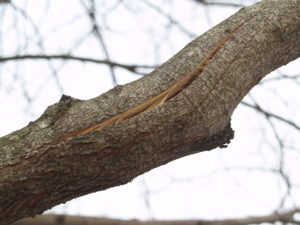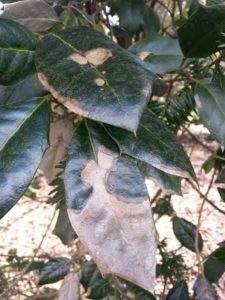Everyone knows it was a tough winter in the mid-Atlantic with school closings, stressful commutes, and bitter cold weather, but now that it is spring, we can put all of that behind us, right? Well, in addition to this winter being difficult on people, it was also damaging to our landscapes. So what should we be looking for on our properties to get them in shape for this upcoming growing season?
Broken branches: The most obvious damage to plants are downed trees or broken branches. Snow and ice can put excessive weight on branches, causing them to break. These branches should be trimmed back to the point where the branch forms, avoiding the branch collar, or swollen area at the base of the branch. This will protect the trunk from decay. If damaged branches are too high to reach from the ground, contact a professional arborist.
Compression damage: Compression damage is basically a branch that is partially broken. The branch may appear to be drooping, or just lower that it had been. Upon inspection, you may see a horizontal split somewhere along the branch. Depending on the severity, the branch may survive, or it may need to be removed. If this branch does not leaf out with the rest of the plant, it is a candidate for removal.
Leaning, partial uprooting: Some trees, like Arborvitae, are susceptible to uprooting, but this may happen to any plant in extreme weather. Check the roots of your trees and shrubs to make sure they are well anchored. If some slight uprooting occurs, it may be possible to save the plant by straightening it back up and staking it for a season. Make sure there is some give in the wires, and that they do not cut into the bark of the tree. A section of garden hose slipped over the wire does a good job of protecting the bark.
Leaf scorch: The leaves on broad-leaved evergreens such as hollies and cherry laurels may look brown at the edges. This is due to winter desiccation or drying out. Unless severe, most broad-leaved evergreens should be able to grow through this winter damage. Some broad-leaved evergreens may look normal now, but fail to push new growth this spring. Keep an eye on these plants as the weather warms up to see how they perform this spring.
Winter kill and cold damage: Crape myrtles, camellias, and other southern plants may have done well over the past several winters, but suffered major damage this year. As with broad-leaved evergreens, we will need to wait and see with some of these border-line plants.
Root rot: Plants that need excellent drainage may be able to survive the cold, but suffer from winter moisture. You may notice that your rosemary or lavender looked fine in February, only to die in March. This occurs when the snow melts and the soil remains wet for extended periods. If this happens choose replacement plants better suited to the existing garden conditions, or amend the soil to ensure appropriate drainage.
Deer and rodent damage: The extreme winter weather affected everyone this year, including animals. Deer resorted to eating plants they would not normally eat, such as hollies. Many of these trees will grow through this winter browse, and should fare better next year if the winter is milder. Other damage caused by animals can be much more damaging. Voles and other rodents burrow under the snow and gnaw on the bark of trees and shrubs. You may notice a ring of damage to the bark right above the ground level. Although it does not look as dramatic as broken branches, this damage will often kill the plant by disrupting the flow of water and nutrients from the roots to the leaves.
So as the weather warms, and you get a chance to get outside, take a few minutes to inspect your property for damage to your landscape. I don’t know about you, but when it comes to spring cleaning, I prefer to do mine outdoors.



